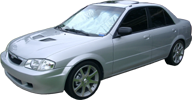Updated March 2010
For those of you who might have some interest in this area, this is about improving the OEM system by making three simple modifications, rather than replacing it with an aftermarket product. To begin with, I strongly suggest that you go to the website of that excellent Australian online magazine: www.autospeed.com
Click on Archived Articles and enter the title, 'Eliminating Negative Boost' in the Search function. This is a five-part article by Julian Edgar on improving a stock air intake system with air box. It is a great tutorial on improving the entire air intake system based on mods derived from measured results rather than guesswork.
Some time ago on the P-Club Forum, while doing a search on air intakes, I came across a post by Traveler titled "Restricted Intake Fix." Noting that the stock air inlet is in a sealed-off location allowing little room for outside air to enter, Traveler cut away the horizontal grill support right under the inlet to the snorkel, thereby exposing the inlet to direct air flow through the grill. He used a Dremel tool with a cutting disc but, not having one myself, I used an X-Acto knife with a cutting blade and a saw to remove the material. The plastic is relatively thin and you can score it and then cut it and snap it out. A bit of a pain but doable. I removed the entire piece except for a stiffening or support rib that connects the front and back of the grill together. This leaves a cut out area ~ 8.75" x 3.5".
Traveler reported that, "The engine now revs cleaner, harder and doesn't feel like it's choking off at 6000 rpm like it did before. It now pulls all the way to redline and my mileage went up by about 1.5 MPG." I obtained results similar to those reported by Traveler. There was a definite increase in throttle response and the engine revved-up more quickly and easily when going to WOT. Definitely more fun to drive. In addition, there was a noticeable increase in intake sound but nothing obtrusive-not at all like an AEM or Injen.
I assume the enhanced throttle response is due to the following factors:
1. The grill is located in a high pressure area.
2. Removal of the horizontal grill support allows the air flow a straight shot to the inlet with a possible ram effect produced by the forward motion of the vehicle.
3. This ram is converted to a slight positive pressure (or at least a reduction in negative boost) as explained in the cited article.
4. The intake air temperature will always be at the ambient-no chance of ingesting hot, underhood air.
Also to be considered is the fact that this is a relatively protected intake. As the air flows through the grill, it must then turn upward to reach the inlet. Since water is heavier than air, I presume much of the water would continue in a straight line or fall away from the inlet. I have, in fact, driven in severe rain storms and have never found that water ever entered the inlet in detectable amounts.
If you read Part 5 of the cited article you will see the dramatic reduction in negative boost the author was able to achieve by locating the air intake in a high pressure area. He was able to maintain atmospheric pressure in the system all the way up to the air box and, at anything less than full throttle, a measureable POSITIVE pressure. I am certainly not implying that I obtained comparable results from my mod. The point is to illustrate that locating the intake in a high pressure area can have beneficial results to a greater or lesser degree.
Below, photo of the engine bay illustrating the modified grill area:
For those of you who might have some interest in this area, this is about improving the OEM system by making three simple modifications, rather than replacing it with an aftermarket product. To begin with, I strongly suggest that you go to the website of that excellent Australian online magazine: www.autospeed.com
Click on Archived Articles and enter the title, 'Eliminating Negative Boost' in the Search function. This is a five-part article by Julian Edgar on improving a stock air intake system with air box. It is a great tutorial on improving the entire air intake system based on mods derived from measured results rather than guesswork.
Some time ago on the P-Club Forum, while doing a search on air intakes, I came across a post by Traveler titled "Restricted Intake Fix." Noting that the stock air inlet is in a sealed-off location allowing little room for outside air to enter, Traveler cut away the horizontal grill support right under the inlet to the snorkel, thereby exposing the inlet to direct air flow through the grill. He used a Dremel tool with a cutting disc but, not having one myself, I used an X-Acto knife with a cutting blade and a saw to remove the material. The plastic is relatively thin and you can score it and then cut it and snap it out. A bit of a pain but doable. I removed the entire piece except for a stiffening or support rib that connects the front and back of the grill together. This leaves a cut out area ~ 8.75" x 3.5".
Traveler reported that, "The engine now revs cleaner, harder and doesn't feel like it's choking off at 6000 rpm like it did before. It now pulls all the way to redline and my mileage went up by about 1.5 MPG." I obtained results similar to those reported by Traveler. There was a definite increase in throttle response and the engine revved-up more quickly and easily when going to WOT. Definitely more fun to drive. In addition, there was a noticeable increase in intake sound but nothing obtrusive-not at all like an AEM or Injen.
I assume the enhanced throttle response is due to the following factors:
1. The grill is located in a high pressure area.
2. Removal of the horizontal grill support allows the air flow a straight shot to the inlet with a possible ram effect produced by the forward motion of the vehicle.
3. This ram is converted to a slight positive pressure (or at least a reduction in negative boost) as explained in the cited article.
4. The intake air temperature will always be at the ambient-no chance of ingesting hot, underhood air.
Also to be considered is the fact that this is a relatively protected intake. As the air flows through the grill, it must then turn upward to reach the inlet. Since water is heavier than air, I presume much of the water would continue in a straight line or fall away from the inlet. I have, in fact, driven in severe rain storms and have never found that water ever entered the inlet in detectable amounts.
If you read Part 5 of the cited article you will see the dramatic reduction in negative boost the author was able to achieve by locating the air intake in a high pressure area. He was able to maintain atmospheric pressure in the system all the way up to the air box and, at anything less than full throttle, a measureable POSITIVE pressure. I am certainly not implying that I obtained comparable results from my mod. The point is to illustrate that locating the intake in a high pressure area can have beneficial results to a greater or lesser degree.
Below, photo of the engine bay illustrating the modified grill area:




Comment